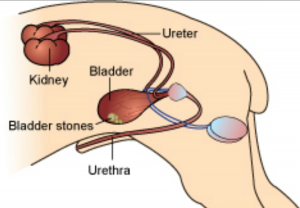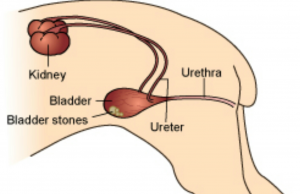Cystotomy Veterinary Coconut Grove Fl
Grove Animal Hospital Veterinarian
A cystotomy is a surgical procedure performed on the urinary tract. There a few reasons as to why your pet may need to have a cystotomy. There can be bladder stones, bladder tumors, or blood clots. To determine if your pet even needs to have a cystotomy, the veterinarian may take radiographs, perform a urinalysis, run blood tests, or do an ultrasound. When a cystotomy is performed, the abdominal cavity does need to be opened up. The surgery usually last for about an hour and your pet will probably need a few days of post-operative care at the veterinary hospital.
URINARY STONES
Associated Terms:
Bladder Stones, Ureteral Stones, Urethral Stones, Kidney Stones, Cystotomy, Urolithiasis, Cystic Calculi, Hematuria, Blood in urine, Peeing / urinating blood, Can not urinate, straining to urinate.
What are urinary stones?
Urinary stones are pieces of solid material that form in the pet’s urinary tract when minerals in the urine become very concentrated. They can form at any part of the urinary tract.
On the pictures below you can see the parts of the urinary tract of both male and female dogs. Please note the difference in the length of the urethras. You can see that the male’s urethra is much longer. This is an important factor in urinary issues. Males’ urethra is longer and narrower and therefore males have smaller chance to get ascendant urinary tract infections (bacteria “crawl” from the skin into the urethra) compared to females. On the other hand males are more prone to have more serious problems when stones are trying to pass. Because of the narrowing and length, the stones are more likely to get “stuck”.
How did my pet get a urinary stone
The stones form in the urinary tract secondary to infection, dietary influences, and genetics. Urinary stones are a common condition in dogs and cats.
- Bacterial urinary tract infection can increase urine salt concentrations and facilitate the stone formation
- Increased dietary intake of minerals and protein and or dehydration in association with highly concentrated urine may contribute to increased saturation of salts in the urine
- Genetics plays role in some breeds. Please check the table below to see if your pet may be predisposed
How do I know my pet has a urinary stone?
The signs that your pet may show depend on the location of the urinary stones and severity of the obstruction. Luckily most urinary stones are located in the urinary bladder or urethra and only a small percentage are lodged in the kidneys or ureters.
Urinary stones can have sharp surface that can damage the lining of the urinary tract causing inflammation and irritation. If the stones are present for longer periods of time, the pressure will damage the walls. This may lead to perforation (rupture) of the bladder, ureters or urethra. Stones can also erode the vessels that may cause bleeding. Chronic irritation of the urinary tract lining may eventually lead to strictures (narrowing).
In severe cases the stones can completely block the urine outflow. This lead to serious problems and may be life threatening if not treated immediately. Complete blockage of the ureters may cause kidney damage. Complete blockage of the urethra can obstruct the urine flow and cause electrolyte imbalances (hyperkalemia) or azotemia (elevated urea and creatinine) or organ rupture that may lead to death.
There may be variety of symptoms:
- blood in the urine
- straining to urinate (crying when urinating, takes longer to urinate)
- urinating small amounts more frequently
- abdominal or lower back pain
- urinary accidents in the house
- drinking more water
- dribbling urine
- straining or posturing to urinate with no urine production
- decreased appetite
- lethargy
- vomiting, diarrhea
- shock
- death
What tests will my veterinarian recommend?
Urinalysis (pH changes and infection may influence crystal/stone formation, specific gravity may indicate any damage of the kidney function)
Urine culture and sensitivity (Some bacteria may be resistant to commonly used antibiotics. This test will provide the information what type of bacteria is present and what antibiotics will eliminate them.)
CBC/Complete Blood Count (Dehydration will increase the concentration of the urine and facilitate stone formation. Chronic bleeding and kidney or ureter stones that affect renal function can cause chronic anemia. Urinary tract infection may become more
serious and cause systemic infection)
Serum chemistry (Elevation of kidney enzymes will reflect severity of the blockage. This test will also rule out any complicating or concurrent illnesses.)
Electrolytes (Elevation of potassium may be life threatening and will require additional treatment)
Abdominal radiographs (Most stones are visible on plain radiographs. Certain stones will not show up well on plain radiographs may be diagnosed
by introducing a contrast agent and/or gas into the urinary tract, usually through a urinary catheter or can be visualized via abdominal ultrasound.)
Abdominal ultrasound (Ultrasound examination can be very useful in evaluation of the kidneys and bladder structure and show stones that are not
visible on the radiographs.)
Abdominal CT scan (CT scan is very useful for small ureteral stones and ruling or kidney disease or cancer throughout the urinary tract)
EKG – Urinary obstruction can cause life threatening heart rate and rhythm abnormalities.
Stone analysis – We send all stones to laboratory for mineral analysis. This will help us to formulate a treatment protocol to prevent stone formation in the future.




